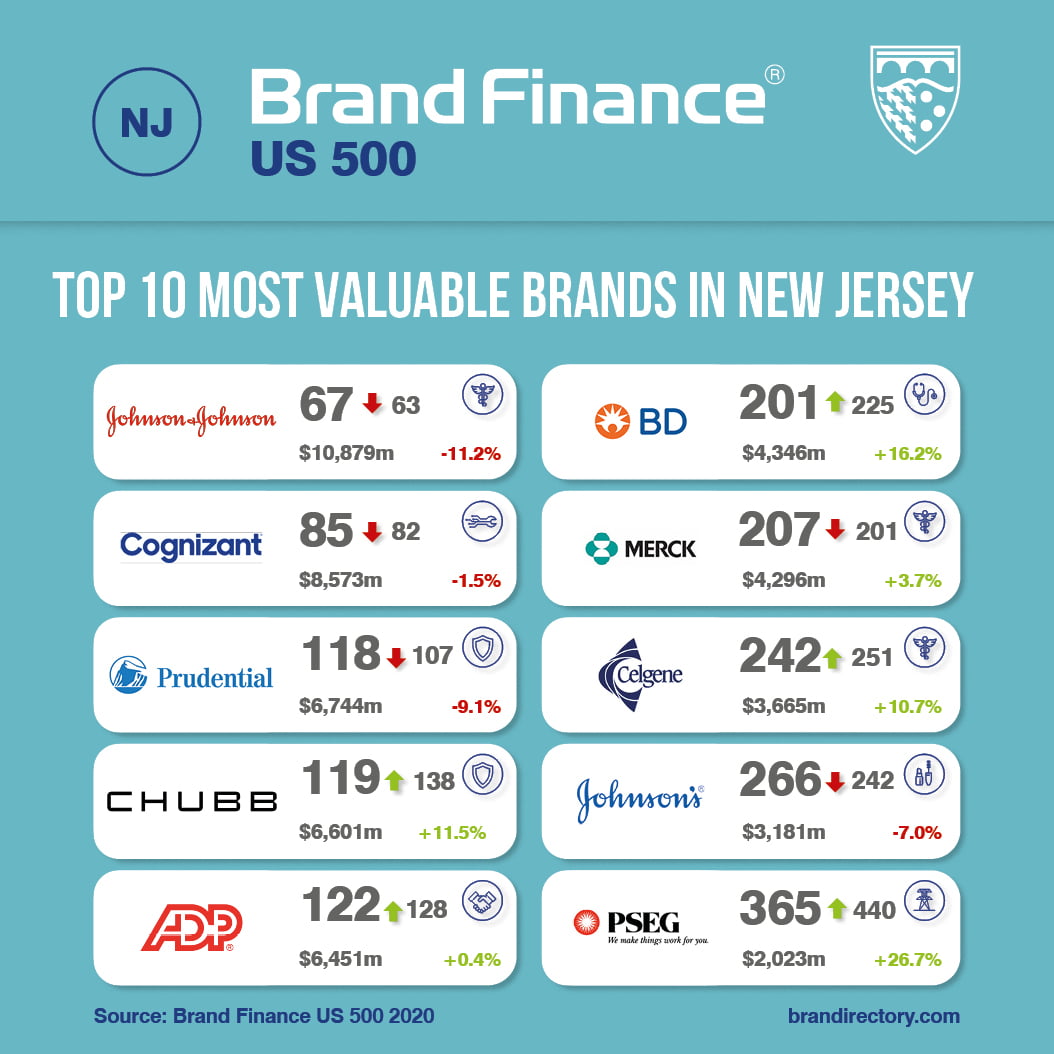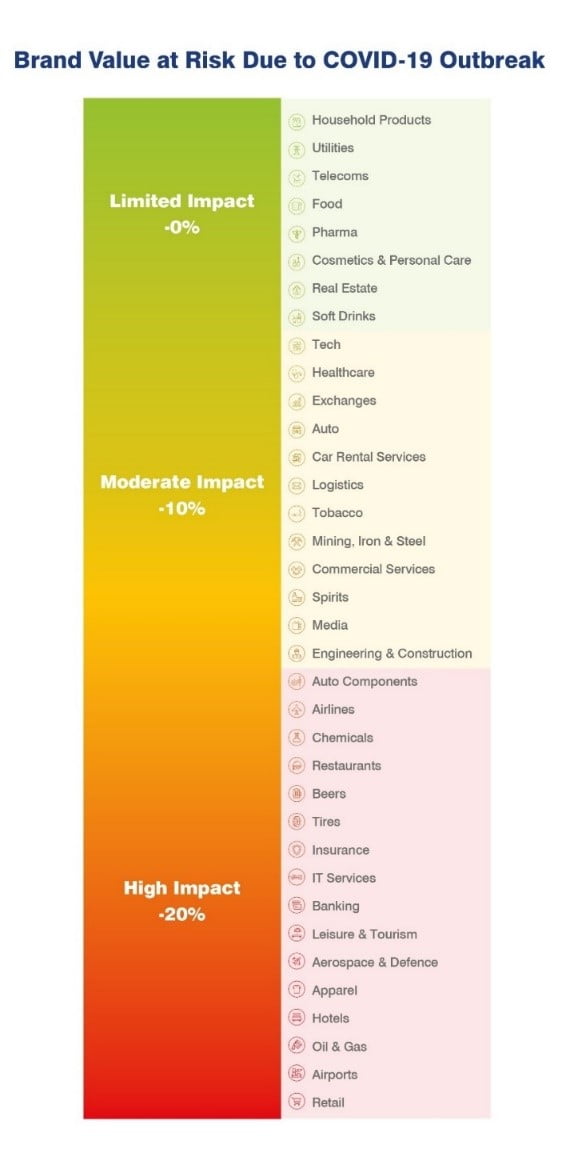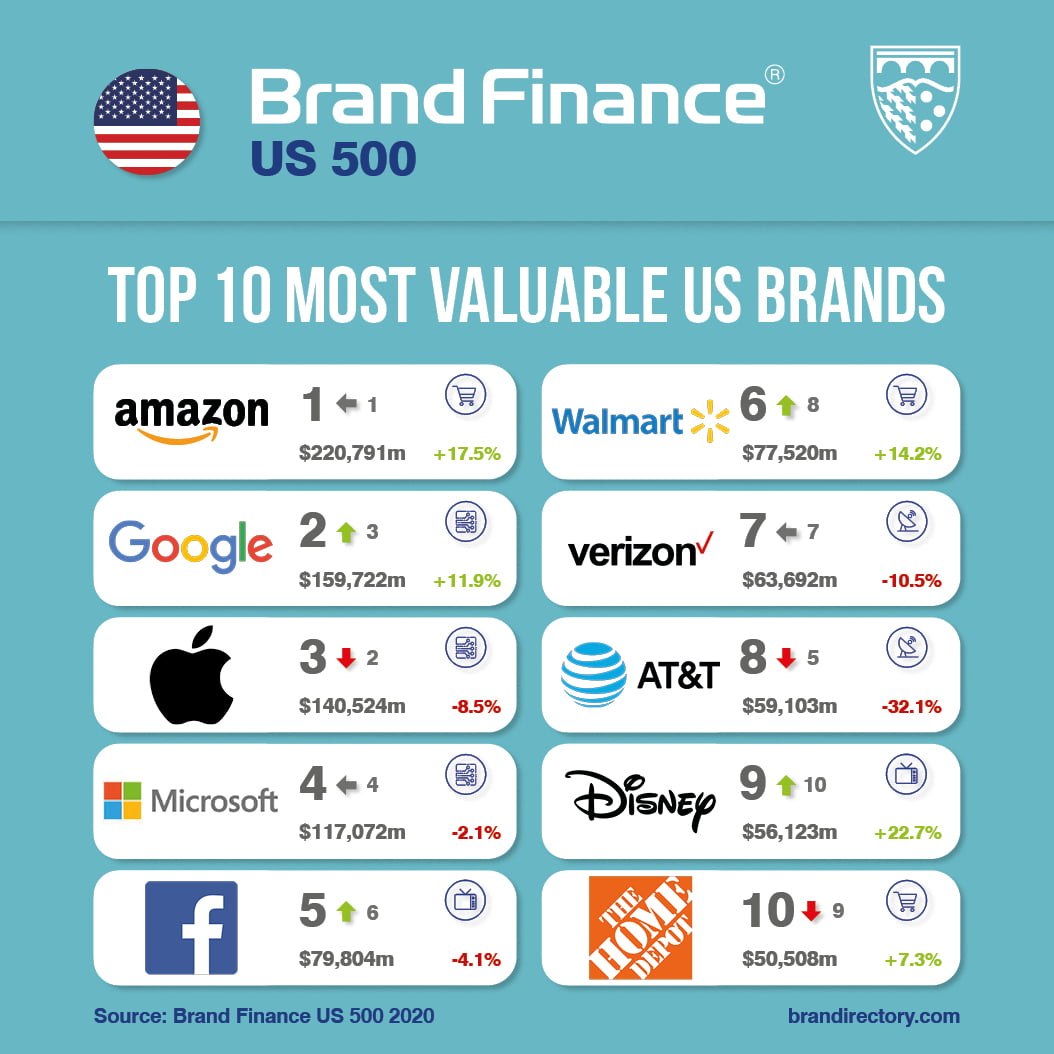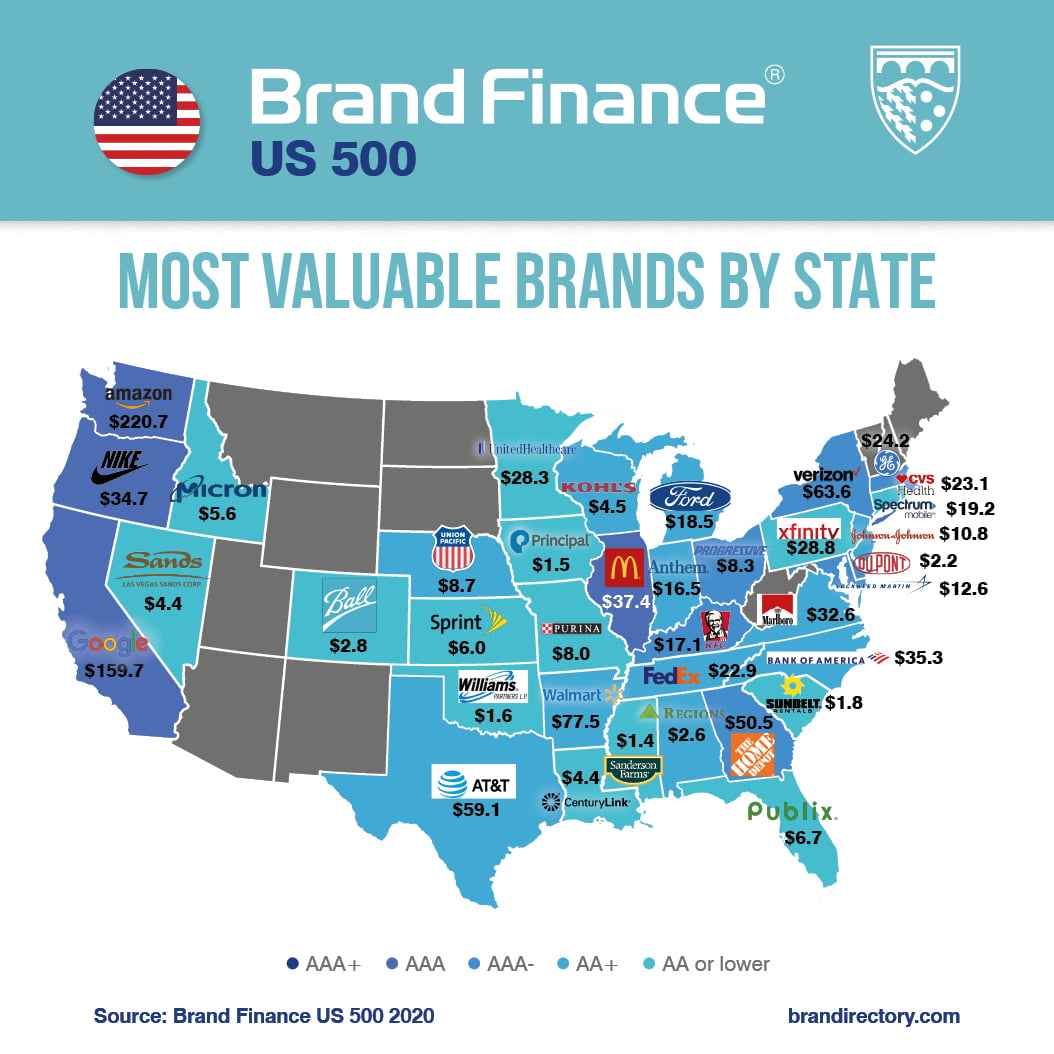By Jacob Wolinsky. Originally published at ValueWalk.
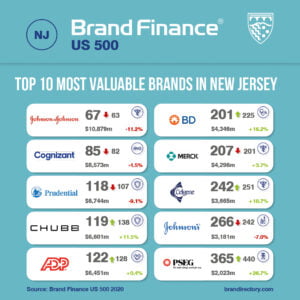
Johnson & Johnson’s Brand Value Continues to Tumble but Tide Could Turn From COVID-19 Pandemic
Q1 2020 hedge fund letters, conferences and more
Brand Finance US 500 Ranking Revealed
- 19 New Jersey brands feature in the newly released Brand Finance US 500 2020 ranking
- New Jersey’s most valuable brand, Johnson and Johnson, continues to lose brand value, but could fare better from COVID-19
- Utilities mainstay PSEG is the fastest growing brand in New Jersey, up 27%
- New Jersey’s brands could lose $7 billion worth of brand value following COVID-19 pandemic
Q1 2020 hedge fund letters, conferences and more
In one of the most comprehensive studies of the brand landscape in the US market, Brand Finance, the world’s leading independent brand valuation consultancy, reveals New Jersey’s Johnson & Johnson as the most valuable brand in the state, valued at $10.9 billion, down 11% from the previous year. The consumer healthcare giant may have had a rockier performance over the last year, but it is poised to perform well out of the COVID-19 crisis.
J&J’s flagship Johnson’s brand is the strongest brand in the state with a Brand Strength Index (BSI) score of 85 out of 100. It’s easy to imagine that Johnson’s will quietly slip into a an even more necessary role in everyone’s lives, as the nation changes its hygiene practices.
Elsewhere in the ranking, utilities mainstay PSEG is the fastest growing brand in New Jersey, its brand value growing 27% to $2 billion. PSEG announced the ambitious goal of achieving net zero carbon emissions by 2050. While this claim may be a dime a dozen in other industries, for a power supply company this is groundbreaking.
The total number of New Jersey brands in the ranking is down from 24 to 19 overall. The future of New Jersey brands is still uncertain, but it is likely that we will see big shifts and changes in the hierarchy, as we are able to take stock of the damage caused by COVID-19. From Brand Finance’s initial calculations, we are predicting that New Jersey’s brands may lose up to $7 billion in brand value.
America’s Top 500 Brands Could Lose up to $400 Billion from COVID-19 Pandemic
As the COVID-19 pandemic wreaks havoc on the global and national economy, America’s top 500 most valuable brands could lose up to 10% of brand value cumulatively, a drop of a staggering US$393 billion compared to the original valuation date of 1st January 2020, according to the latest Brand Finance US 500 2020 report.
Looking beyond the US, the value of the 500 most valuable brands in the world, ranked in the Brand Finance Global 500 2020 league table, could fall by an estimated US$1 trillion as a result of the Coronavirus outbreak.
Brand Finance has assessed the impact of COVID-19 based on the effect of the outbreak on enterprise value, compared to what it was on 1st January 2020. Based on this impact on enterprise value, Brand Finance estimated the likely impact on brand value for each sector. The industries have been classified into three categories – limited impact (minimal brand value loss or potential brand value growth), moderate impact (up to 10% brand value loss), and heavy impact (up to 20% brand value loss) – based on the level of brand value loss observed for each sector in the first quarter of 2020.
Amazon primed for growth as lockdown continues
Amazon remains a cut above the rest in the Brand Finance US 500 2020 ranking, breaking the so far unattainable US$200 billion brand value mark, following 18% growth from US$187.9 billion last year. Amazon’s brand value has now reached US$220.8 billion, substantially ahead of second-placed, Google, with a brand value of US$159.7 billion.
The world’s largest online marketplace, Amazon has also branched out into cloud computing, artificial intelligence, consumer electronics, digital streaming, logistics, and is looking to enter other industries. The majority of Amazon’s revenue still comes from its retail division, however, and despite growing challenges – particularly in its international operations – the brand is untouchable in the sector.
While most brands are experiencing or expecting a slump in revenue during the pandemic, Amazon is set for continued growth. As with fellow e-commerce brands, Amazon has been benefitting from the unprecedented surge in demand as consumers turn online following store closures. With over 100,000 workers hired and more in the pipeline, the brand is fighting to meet this demand. This spike has not come without its challenges, as Amazon’s logistics and supply chain network are being stretched to uncharted levels and the brand’s illustrious next day delivery service is being tested, with fulfilment and third-party vendors extending their lead times considerably. First time users of the platform may not be experiencing the world-leading level of speed that the brand prides itself on, which could jeopardize its long-term reputation.
Laurence Newell, Managing Director, Brand Finance Americas, commented:
“Amazon’s sheer dominance in the e-commerce space should stand them in good stead in the coming months as the world tackles the far-reaching repercussions of the COVID-19 pandemic. Brand Finance has calculated that Amazon’s brand value could grow a further US$4 billion thanks to the spike in demand. Nevertheless, the world’s online marketplace must look beyond the coming months to ensure that quality and speed are not compromised should it wish to maintain its exceptional reputation and thus retain new users.”
Lockdown Boost For Media Brands
With a combined brand value of US$364.5 billion, media is the third most valuable sector in the ranking behind tech and retail, with many brands set for an extra boost from the lockdown.
The highest ranked media brand and the fifth most valuable US brand overall, Facebook (brand value down 4% to US$79.8 billion), has negotiated several high-profile reputational issues, most notoriously the Cambridge Analytica scandal, which resulted in a US$5 billion fine last year. The pandemic could, however, turn the tide on the tarnished brand, as people are forced to keep in touch with friends through social media and scroll down their feeds during the long lockdown days. Facebook has also been developing a symptom survey, which is hoped to reveal a lot about COVID-19 and contribute to research.
In contrast, Facebook-owned Instagram has enjoyed an explosion of growth, securing the fifth highest brand value increase among all US brands this year, up 58% to US$26.4 billion, and jumping up to 29th spot. With more than 1 billion active monthly users and a focus on new technology, like the latest Checkout feature that benefits both consumers and other brands, Instagram is catering to demand and staying relevant. The platform is successfully leveraging its position in the market as a genuine business tool – beyond its traditional influencer market – as more businesses move online during lockdown.
YouTube has also enjoyed a steady growth over the course of last year (up 17% to US$44.5 billion), climbing from 13th to 11th position. With 300 hours of video uploaded to YouTube every minute and 5 billion videos watched every day, the platform has only increased in popularity during COVID-19, becoming both an outlet for coronavirus-related news, as well as a source of entertainment as people around the world spend more time indoors.
In line with positive trends in brand value among other video streaming services, last year also saw Netflix enjoy an 8% boost in brand value to US$22.9 billion. Netflix has been a pioneering force in changing consumers’ viewing habits, taking over traditional television by providing a more appealing, flexible option in line with the modern fast-paced lifestyle. This success has only been spurred on by COVID-19, with the timely release of Tiger King raking in 34 million US viewers in the first 10 days alone.
Network television continues to lag behind online competitors, best exemplified by Fox being the fastest falling US brand this year, with a 47% decrease in brand value to US$8.4 billion, and dropping 39 positions on the ranking to 88th place. Around the country, similar challenges are faced by competitors who suffer at the hands of increasing demand for streaming services, for instance Discovery (down 32% to US$3.4 billion) and TBS (down 20% to US$2.3 billion).
In contrast, the shining star among traditional media brands, Disney (up 23% to US$56.1 billion) is no longer just children’s films or vacation spots – with the acquisition of 21st Century Fox, the company has secured its place as a leader in the industry. Disney has also put an emphasis on delivering direct-to-consumer experience. With the recent launch of Disney+, perfectly timed as Americans remain at home, the brand intends to take on Netflix and other emerging rivals such as HBO Max.
In addition to calculating overall brand value, Brand Finance also determines the relative strength of brands through a balanced scorecard of metrics evaluating marketing investment, stakeholder equity, and business performance. Alongside revenue forecasts, brand strength is a crucial driver of brand value. According to these criteria, Disney is also the strongest brand in the US with a Brand Strength Index (BSI) score of 93.9 out of 100 and a corresponding elite AAA+ brand strength rating.
Laurence Newell, Managing Director, Brand Finance Americas, commented:
“Consumers’ viewing habits have been transformed with the rise of streaming services. Under the current COVID-19 lockdown, it remains to be seen whether traditional television will be better positioned to compete with streaming services, or whether their brand values will continue on a downward trend for the rest of the year.”
Call For Help For Telecoms Brands
A call to the help desk may be in order for the telecoms industry, as the majority of brands – 7 out of 9 – saw their brand value decline last year, despite strong investments. Big telcos are being squeezed from all sides as OTT messaging apps like WhatsApp are impacting voice and SMS revenue, and challenger brands offer comparable data services at below-market rates, leading to fierce price competition and decreasing margins.
US giant AT&T is the fastest-falling large telecoms brand this year, down 32% to US$59.1 billion. The company diversified its entertainment portfolio over the last few years, culminating with the acquisition of WarnerMedia, part of a plan to move away from reliance on the traditional telco business and pay television, as both revenue streams have been drying up over the last years. The upcoming launch of HBO Max with WarnerMedia, which will compete with over-the-top (OTT) media brands like Netflix, should help propel the company forward.
For the first time since 2016, Verizon has overtaken AT&T as the nation’s and world’s most valuable telecoms brand, with a brand value of US$63.7 billion. In the battle of the American telco titans, Verizon is commended for its overall performance, network reliability, network speed, data performance, call and text performance.
The COVID-19 crisis poses both a stress test of network capabilities as well as an opportunity to regain a reputation for reliability and a closer, positive relationship with customers which many brands have lost. So far, we see telecoms brands as only being lightly affected by this crisis, but it remains to be seen brand by brand, who takes advantage of the opportunity and who falters.
Laurence Newell, Managing Director, Brand Finance Americas, commented:
“The telecoms industry is one of the few sectors of the economy avoiding direct negative impact of COVID-19. Moreover, telecoms brands have the opportunity to embrace the working from home revolution, which has led to extraordinary demand for remote working resources and connectivity. However, as the pandemic struck at a low point for the industry, the competition to make the most of the growing demand will be fierce.”
Make Or Break: Banking
America’s most valuable banking brand, Wells Fargo has had its share of reputational issues in recent years, and according to Brand Finance’s customer research, out of the 34 financial institutions covered in the US, Wells Fargo is ranked last in reputation. Despite this, Wells Fargo saw a moderate increase in brand value of 2%, with its rivals in retail banking such as Bank of America (down 4% to US$35.4 billion), Citi (down 9% to US$33 billion), and Chase (down 14% to US$31.3 billion) all declining in value year on year.
Laurence Newell, Managing Director, Brand Finance Americas, commented:
“The banking sector is no stranger to turbulent times and banks globally and at home are likely to face a difficult journey ahead, with a potential 20% brand value loss from COVID-19. Brand Finance has calculated that Wells Fargo stands to lose the most brand value, with up to US$8 billion at stake. Banks’ response and contingency plans will be critical in the coming months as the global economy faces unprecedented disruption.”
The most valuable new entrant from the banking sector is Truist, which was formed after the acquisition of SunTrust Bank by BB&T, forming the 8th largest bank in the US. The decision to go with a new name has come under criticism since the launch in early 2020. Before the rebranding, BB&T had the highest rated customer service score out of all American banks surveyed by Brand Finance, the 5th best reputation, and ranked 4th for consideration among those aware of the brand.
Another new entrant from the banking sector, Ally Financial’s brand value has more than tripled in 4 years. Its brand value growth has been supported by significant investment in marketing, including a series of creative and relevant campaigns which play homage to Ally’s disruptive brand vision. In the latest wave of Brand Finance’s customer research, Ally achieved the highest rate of association with innovation and with having excellent website & apps, compared to all other US retail banks in the study.
Long Haul Problems For Airlines
Prior to the coronavirus outbreak, Delta (down 9% to US$9.2 billion) held on to its position as the most valuable airlines brand in the world, with its drop in brand value attributed to scoring lower for customer familiarity, satisfaction, and preference than in previous years. All US airline brands, including American Airlines (down 7% to US$8.9 billion) and United Airlines (down 3% to US$8.2 billion), have dropped in brand value following lower market research ratings and in effect falling Brand Strength Index (BSI) scores. Predicted to drop by a further 20% in line with industry trends, aviation is an illustrative example of the effect COVID-19 can have on brand value.
Apparel Brands Under Threat
For the sixth consecutive year Nike has claimed the title of the world’s most valuable apparel brand and therefore continues to lead in the US, recording a 7% increase in brand value to US$34.8 billion, as of 1st January 2020. The sports giant has focused on implementing a pivotal distribution strategy move, drastically reducing the number of retailers selling its products, with the aim of regaining control of the brand customer relationship and improving profit margins. Nike will have to rely on its dominant position in the coming months as Brand Finance’s analysis has shown the brand is likely to be one of the most affected by COVID-19 with up to US$7 billion worth of brand value of stake.
Laurence Newell, Managing Director, Brand Finance Americas, commented:
“The COVID-19 pandemic is undoubtedly going to hit the apparel sector hard – Brand Finance has predicted that apparel brands, like airlines and hotels, could face up to a 20% drop in brand value. As these brands negotiate store and factory closures, broken supply chains, and a customer base that is facing unprecedented economic uncertainty, they will have to prepare for a tough journey ahead.”
About Brand Finance
Brand Finance is the world’s leading independent brand valuation consultancy, with offices in over 20 countries. Brand Finance bridges the gap between marketing and finance by quantifying the financial value of brands.
Brand Finance helped craft the internationally recognized standard on Brand Valuation – ISO 10668, and the recently approved standard on Brand Evaluation – ISO 20671.
Brand Finance is a chartered accountancy firm regulated by the Institute of Chartered Accountants in England and Wales (ICAEW), and also the first brand valuation consultancy to join the International Valuation Standards Council (IVSC).
Brand Finance’s brand value rankings have been certified by the Marketing Accountability Standards Board (MASB) through the Marketing Metric Audit Protocol (MMAP), the formal process for validating the relationship between marketing measurement and financial performance.
Methodology
Brand Finance has assessed the impact of the COVID-19 outbreak based on the effect of the outbreak on enterprise value, compared to what it was on 1st January 2020. Based on this impact on enterprise value, Brand Finance estimated the likely impact on brand value for each sector. The industries have been classified into three categories – limited impact (0% brand value loss), moderate impact (up to 10% brand value loss), and heavy impact (up to 20% brand value loss) – based on the severity of enterprise value loss observed for the sector in the first quarter of 2020
Definition of Brand
Brand Finance helped to craft the internationally recognized standard on Brand Valuation – ISO 10668. It defines a brand as a marketing-related intangible asset including, but not limited to, names, terms, signs, symbols, logos, and designs, intended to identify goods, services or entities, creating distinctive images and associations in the minds of stakeholders, thereby generating economic benefits.
Brand Strength
Brand strength is the efficacy of a brand’s performance on intangible measures, relative to its competitors. In order to determine the strength of a brand, we look at Marketing Investment, Stakeholder Equity, and the impact of those on Business Performance.
Each brand is assigned a Brand Strength Index (BSI) score out of 100, which feeds into the brand value calculation. Based on the score, each brand is assigned a corresponding Brand Rating up to AAA+ in a format similar to a credit rating.
Brand Valuation Approach
Brand Finance calculates the values of the brands in its league tables using the Royalty Relief approach – a brand valuation method compliant with the industry standards set in ISO 10668. It involves estimating the likely future revenues that are attributable to a brand by calculating a royalty rate that would be charged for its use, to arrive at a ‘brand value’ understood as a net economic benefit that a brand owner would achieve by licensing the brand in the open market.
The steps in this process are as follows:
- Calculate brand strength using a balanced scorecard of metrics assessing Marketing Investment, Stakeholder Equity and Business Performance. Brand strength is expressed as a Brand Strength Index (BSI) score on a scale of 0 to 100.
- Determine royalty range for each industry, reflecting the importance of brand to purchasing decisions. In luxury, the maximum percentage is high, in extractive industry, where goods are often commoditized, it is lower. This is done by reviewing comparable licensing agreements sourced from Brand Finance’s extensive database.
- Calculate royalty rate. The BSI score is applied to the royalty range to arrive at a royalty rate. For example, if the royalty range in a sector is 0-5% and a brand has a BSI score of 80 out of 100, then an appropriate royalty rate for the use of this brand in the given sector will be 4%.
- Determine brand-specific revenues by estimating a proportion of parent company revenues attributable to a brand.
- Determine forecast revenues using a function of historic revenues, equity analyst forecasts, and economic growth rates.
- Apply the royalty rate to the forecast revenues to derive brand revenues.
- Brand revenues are discounted post-tax to a net present value which equals the brand value.
The post Johnson & Johnson’s Brand Value Continues to Tumble appeared first on ValueWalk.
Sign up for ValueWalk’s free newsletter here.



